Wednesday, 19 April 2023
Morning Keynote
“Artificial Intelligence for Aviation”
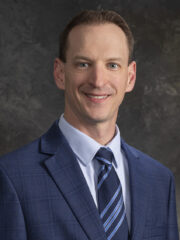
Justin Taylor, Vice President, Lockheed Martin Artificial Intelligence Center
Justin Taylor is vice president of Artificial Intelligence for Lockheed Martin within Corporate Engineering & Technology. In this capacity, he is responsible for driving artificial intelligence (AI) and machine learning (ML) as an engineering discipline, coordinating the corporation’s AI/ML technology strategy, and leading the LM AI Center (LAIC).
Previously, Mr. Taylor was engineering director, Lockheed Martin Aeronautics, for the Advanced Development Programs (ADP) Skunk Works ISR portfolio. In that role, he was responsible for the weapon systems development of the ISR portfolio of platforms. He also served as the program manager for the corporate-level Joint All Domain Operations (JADO) program, in which he coordinated technology development and integration of multi-domain capabilities across all business areas, with an emphasis on accelerating the fielding of system of systems capabilities.
He previously served as program management director, Lockheed Martin Aeronautics, for the Skunk Works Mission Systems Roadmaps organization. In that role, he was responsible for identifying, maturing, demonstrating, and transitioning key technology to address mission needs for all aeronautics platforms.
Plenary III: Future of ATM
Co-chairs

Steve Bradford, Chief Scientist for Architecture and NextGen Development, FAA
Steve Bradford is chief scientist for architecture and NextGen development, Office of NextGen, at the Federal Aviation Administration. He is the chair of the technical review board that monitors technical decisions related to investments and enterprise architecture. He is the FAA lead for the FAA/NASA Research Transition Team (RTT) process that supports collaboration between the FAA and NAS on ATM related activities. A current focus of the RTT process is collaboration on UAS-in-the-NAS supporting vehicles operating in ATM, and UAS traffic management supporting operation in uncontrolled airspace, and AAM. The RTT process depends on direct partnership with the UAS industry and provide many opportunities to look at new technology options for both new entrants and traditional manned aircraft operations.
He also has a leading role in NextGen’s International engagement activities with SESAR Joint Undertaking and has led several co-operative international efforts with EUROCONTROL He was a member of the International Civil Aviation Organization’s (ICAO) technical team that authored the Global Air Navigation Plan, the past U.S. panel member to the ICAO Air Traffic Management Requirements and Performance Panel, and the Chair for the ICAO GANP Study Group.
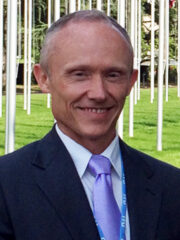
Luc Emberger, Communication and Surveillance Senior Expert, AIRBU.S.
Luc Emberger was appointed communication and surveillance senior expert in 2019 after more than 20 years working on data link project with Airbus. In this function, he contributes to air/ground communications roadmaps and connectivity strategy at aircraft level. He also contributes to R&T activities to mature the future ATM concepts and pave the way to a more connected aircraft.
Among his main responsibilities, he represents Airbus in several Standardization bodies (AEEC, RTCA, EUROCAE), as chairman for EUROCAE WG-78 on air traffic services and AEEC ATN/IPS. He contributes to frequency and spectrum topics coordination across all Airbus divisions.
Prior to assuming this position, he served as data link communication expert, and as communication equipment’s development leader at the Airbus design office, and he certified the first Airbus data link system flying in Europe.
Panelists
Steve Bradford and Luc Emberger, “Future Connectivity for Aviation”
See biographies above.
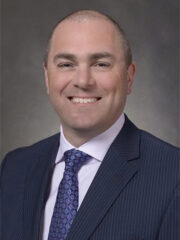
Greg Saccone, Technical Fellow, Airspace Operational Efficiency, Boeing Research & Technology, “Transition to Trajectory-based Operations”
Greg Saccone has worked for more than 30 years in the aeronautical data link communication area. At Boeing he works in the Airspace Operational Efficiency group on advanced air traffic management concepts, research, operational trials, and implementation, specializing in data link communication and flight data processing. He is the focal for Internet protocol suite projects at Boeing, leading both internal and joint industry research projects, and is currently the co-chair of the Airlines Electronics Engineering Committee (AEEC) Internet Protocol Suite for Aviation Safety Services group. Additionally, he has been active in the ICAO Aeronautical Communications Panel and the RTCA SC-214 NextGen Data Link group, serving as co-chair of the Validation Subgroup.
Prior to joining Boeing, he was the technical director of data link research and development projects at Raytheon Canada, investigating implementing and integrating data link applications into flight data processor functionality of Raytheon commercial and military air traffic control systems. He also authored various Aeronautical Telecommunications Network (ATN) data link industry standards and acted as the air-ground applications sub-group chairman for the ICAO ATN Panel.
Greg holds a degree in electrical engineering with honors and has several patents on aeronautical communications and air traffic management innovations.

Stephen Van Trees, Senior Engineer, Comm. & Surv. Technologies, FAA Aviation Safety – Aircraft Certification Service, “Certification Perspective on Hyper Connected Aircraft”
Stephen P. Van Trees is a senior engineer in the Avionics and Electrical Systems section, Technical Policy Branch, Policy and Standards Division, Aircraft Certification Service, Aviation Safety Service, Federal Aviation Administration, Washington, DC. His group works in data communications, weather systems, and unmanned aircraft systems (UAS).
He is a charter member of RTCA SC-228, the government-industry body responsible for developing means of compliance and performance standards for operation of large UAS in controlled airspace. He is currently GAR for SC-228. He is also co-chair of WG2, Command and Control.
Over the last ten years SC-228 has produced the suite of MOPS for both Detect and Avoid (DAA) and Command and Control. These standards have been recognized by the RPAS Panel at ICAO. The FCC has also recently proposed recognition of SC-228 MOPS in C-Band spectrum considerations.
Steve is also a charter member of the NAS Enterprise Architecture work. He works as aircraft roadmap lead, which serves to integrate avionics advancements with NAS evolution.
Over the last 27 years with the FAA, he has held a variety of technical and management positions, including six years as manager, Avionics Systems Branch (AIR-130). The branch was the first in the FAA to manage UAS integration.
He joined the FAA as an engineer in the data communication area, after working in a lead role in the U.S. teams for development of the ICAO SARPs for the Aeronautical Telecommunication Network (ATN), and the FANS-1 specification.
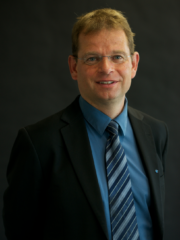
Paul Bosman, Head of Infrastructure Division, Network Manager Directorate, EUROCONTROL, “European Air-Ground Datacom Way Forward”
Paul Bosman has been with EUROONTROL for nearly 30 years, working in many different technical and managerial positions in different locations. He is currently the head of the Network Manager – Infrastructure Division. He is responsible for planning, deploying, and monitoring European infrastructure and aiming to digitise the SES European Sky through activities such as CNS, information management, AI and overall resilience (cyber, interference), as well managing major pan-European common services such as ARTAS/SDDS/SASS-C, EAD, NewPENS and air-ground datalink common procurement.
Plenary IV: The Role of Information Centricity in the Future of ATM
Co-chairs

Dr. Stéphane Mondoloni, Chief Engineer, NAS Vision and Research, MITRE
Dr. Stéphane Mondoloni leads the Aviation Future Concepts & Architecture Outcome at the MITRE Corporation. In this role, he works with FAA sponsors to define and execute research and analysis seeking to achieve the Info-Centric NAS. This includes research into the feasibility and applications for the Connected Aircraft concept. Previously, he led the MITRE team collaborating with the FAA to define this future Info-Centric NAS vision.
He has conducted research in air traffic management (ATM) for over 20 years and authored over 50 technical publications and future concepts. Research interests include ATM simulation, optimization, and operational performance evaluation and improvement. For over 15 years, he has participated on an ICAO panel to develop visionary ATM concepts including the Connected Aircraft, Trajectory-Based Operations (TBO), and the Flight and Flow Information for a Collaborative Environment (FF-ICE). Dr. Mondoloni has collaborated with international partners to mature these concepts with several on the path to implementation.
Dr. Mondoloni received his doctorate from MIT in aeronautical engineering and an MBA from the IESE Business School. He is a fellow of the Royal Aeronautical Society and an associate fellow of the American Institute for Aeronautics and Astronautics.

Dr. Parimal Kopardekar, Director, NASA Aeronautics Research Institute (NARI)
Parimal Kopardekar (PK) serves as the director of NASA Aeronautics Research Institute (NARI). In this capacity, he is responsible for exploring new trends, research areas, collaborations, and partnerships relevant to aeronautics enterprise. Recently, he co-led a comprehensive needs assessment study for wildfire mitigations. In the past, he served as NASA’s senior technologist for Air Transportation Systems. He invented Unmanned Aircraft System Traffic Management (UTM) to safely enable large-scale drone operations at lower altitudes, which is now being globally adopted. He also chairs the International Civil Aviation Organization (ICAO)’s unmanned aircraft system advisory group.
He is a recipient of many awards, including the NASA Government Invention of the Year, NASA Exceptional Technology Achievement Medal, NASA Outstanding Leadership Award, NASA Engineer of the Year Award, and the prestigious Samuel J. Heyman Service to America’s Promising Innovation Award. PK was named among 25 most influential people in the drone industry. He serves as the co-editor-in-chief of Journal of Aerospace Operations and is a fellow of the American Institute of Aeronautics and Astronautics.
He also serves as an adjunct faculty and teaches undergraduate and graduate-level courses related to operations management, supply chain management, and innovation. He holds a doctorate and Master of Science degrees in industrial engineering and a bachelor’s degree in production engineering.
Panelists

Jon Jenkins, Senior Director for FMS and Flight Controls products, Honeywell, “Cloud-based FMS”
Jon Jenkins is the senior director of engineering for the Flight Systems Center of Excellence (COE) at Honeywell Aerospace. The Flight Systems COE is responsible for flight management systems, flight control systems, and air data systems. In this role Jon is responsible for program execution, supporting pursuits of new business, and quality improvement initiatives for the product lines. Honeywell Flight Systems develops products for air transport, business & regional jets, helicopters, and defense & space segments.
Jon brings extensive experience in leadership and engineering management development to Honeywell. Prior to his current role Jon led the formation of the Engineering Execution Transformation (EET) organization for Honeywell Aerospace Electronic Solutions. As director of EET he helped standardize how we plan track and execute large scale engineering development programs.
Before EET Jon was the director of engineering for our Next Generation Flight Management System (NGFMS). NGFMS is a software product line designed to maximize re-use of not only software but all artifacts including requirement and verification documentation.
Jon has 25 years of experience with Honeywell including experience in systems, software, test, and certification activities. His teams have been major innovation drivers for Honeywell and have won multiple technical achievement awards and hundreds of patents.
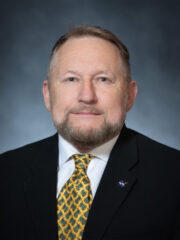
Paul Hoyt Nelson, Senior Cybersecurity Advisor, Aeronautics Research Mission, NASA, “Security”
Paul Hoyt Nelson currently leads the NASA Aeronautics Research Mission’s cybersecurity efforts as the senior cybersecurity advisor. This is a multifaceted architect and management role that includes leading the research and development of aviation cybersecurity capabilities as well as ensuring that all R&D work results in secure and securable technologies for NASA’s diverse stakeholders. He also serves as NASA’s principal aviation cybersecurity liaison to U.S. government agencies and industry stakeholders. In addition, Paul works as an integration program manager in the Airspace Operations and Safety Program where he addresses the difficulties in cross-cutting integration of security and communications across the airspace ecosystem.
He has previously been a NASA chief information security officer (CISO), director of research and development for the NASA Office of Inspector General Computer Crimes Division (CCD) (federal law enforcement), a CCD investigator and has been lead systems and security architect, as well as personnel manager, for many NASA and industry initiatives. With over 35 years of experience in systems, network and security architecture, as well development and operations, he has consistently designed his roles to include staff mentoring and development and program management. This has provided a strong basis for success in these fast-changing technology areas as well as helping to ensure the continued development of scarce talent.
Paul earned a dual degree from Bowling Green State University in computer science and chemistry. He holds a Certified Information Systems Security Professional (CISSP) certification from (ISC)2 and a Seized Computer Evidence Recovery Specialist (SCERS) certification from the Federal Law Enforcement Training Center (FLETC). He has publications with IEEE, SANS, and other security industry conference proceedings.

Brandon Suarez, Vice President of UAS Integration Reliable Robotics, “Digital Flight”
At Reliable Robotics, Brandon leads the development of technical standards and global aviation policy for the company. He is focused on defining key aspects of the development roadmap, including airspace integration and international operational approval, and supports product strategy plans and future aircraft programs.
Prior to joining Reliable, Suarez was the technical director for UAS Civil Airspace Integration at General Atomics Aeronautical Systems, Inc. where he led the company’s efforts to safely integrate remotely piloted aircraft systems (RPAS) into domestic, foreign, and international airspace. He also led a collaborative team of experts from the FAA, NASA, and several industry partners to bring together the technology needed for a Detect and Avoid (DAA) system on a Predator B RPAS.
Suarez is deeply involved in the aviation community. He serves as a co-chair of the Aerospace Industry Association’s Advanced Air Mobility Subcommittee bringing together diverse segments of the industry to advocate for common policies. He is an advisor to the International Civil Aviation Organization (ICAO), working to make RPAS a normal part of the global aviation ecosystem. He is a c-chair of RTCA Special Committee 228, which has developed FAA-recognized standards for DAA systems and UAS datalinks, two critical enabling technologies. He is also active in several NASA research activities seeking to advance future aviation concepts.
Suarez earned a Bachelor of Science and a Master of Science in aerospace engineering from the Massachusetts Institute of Technology. He is also an instrument-rated commercial pilot.
Evening Network Event
Trivia Madness
17:30 to 19:30

